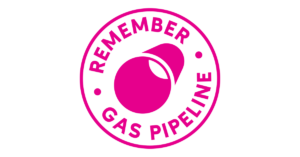Safety
Special attention to the safety of gas transmission has been paid throughout the history of gas use in Finland, and we have succeeded well in this work. Globally the most typical incident relating to natural gas is damage to a gas pipeline caused by excavating machinery.

Activities taking place in the vicinity of Finland’s high-pressure natural gas pipelines require an on-site pipeline location guidance visit and a statement procedure aiming to prevent damage to the infrastructure.
Conditions for activities are laid down in Government Decree on Safety in the Handling of Natural Gas (551/2009), for which application guidelines have been produced by the Finnish Safety and Chemicals Agency (Tukes). Gas pipeline maintenance, careful planning of any changes, and continuous process monitoring help guarantee incident-free transmission of gas.
We pay special attention to risks related to health and safety at work. Identifying safety and environmental risks and opportunities is part of our regular activities. Various risk assessments take place in the context of projects, depending on the scope of the project. We also make instant risk assessments while performing our normal day-to-day work before starting work. All these assessments help ensure good identification of hazards and risks and the application of corrective measures concerning any risks.
- Contact us:
- customerservice@gasgrid.fi
- Attachments:
- Safety Data Sheet
Security of supply
Gasgrid Finland is assigned with system responsibility under the Natural Gas Market Act. This obliges us to ensure the security of gas supply to customers.
The supply security of natural gas has remained excellent for decades. In case of a disturbance, natural gas regasified from liquefied natural gas (LNG) can be injected into the pipeline network. In addition, security of supply was increased in late 2019 as the introduction of the Balticconnector pipeline provides an alternative import route. Unforeseen supply disruptions are very rare, and the most common reason for planned and temporary supply interruptions is scheduled maintenance or connection work.
A key element in security of supply is maintaining the level of pressure in the transmission network at a level suitable for the market situation. To ensure this, we use colour codes (green, yellow and red) to indicate the status of the network.
The Green Zone indicates the zone within which the system’s forecast imbalance for the gas day may vary before we carry out balancing actions within the gas day by buying or selling gas on market terms to achieve physical balance. If the gas system enters the Yellow Zone, we begin within-day trading in balance gas to take network status back to the Green Zone. The price of the within-day transactions executed affects the price of imbalance charges payable by market actors. The system entering the Red Zone indicates a crisis situation, which is when we launch measures to restrict gas consumption while ensuring, however, that gas deliveries to protected customers are not jeopardised.
Objectives and principles of our safety and security work
Our operations are based on a culture of high safety and security where the supply security of natural gas plays a key role. Our safety and security work objective is that no damage, accidents or injuries take place in our activities or in the end use of gas.
Our safety and security principles are as follows:
- We maintain and develop our safety and security culture systematically.
- Everyone is permitted and obliged to address unsafe activities and look after people’s wellbeing.
- We provide training in, follow and monitor the safety and security guidelines and safe work methods determined.
- We record and investigate all incidents relating to safety and security.
- We take safe access and mobility into account in our operations.
- We expect our partners to have a corresponding safety and security culture.
Safety and security in the supply chain
As a Finnish gas sector expert, we take responsibility for safety and security in natural gas transmission. Contact us in case of any leaks or accidents relating to transmission pipelines.
In case of an emergency, contact our Central Control Room on 05 3751 555 or call the Emergency Response Centre number 112.
We act responsibly and require that our service providers and critical goods suppliers as well as projects comply with the safety and security as well as operating principles determined by us. We also require that the subcontractors of our direct contractual partners comply with a corresponding level of safety and security. We require that our suppliers comply with our targets of zero accidents, zero environmental disturbances, zero property damage and zero supply interruptions.
Any deviations detected in activities must be reported to us immediately. Every accident, environmental disturbance, property damage or their risk is investigated in collaboration to determine the corrective measures required.
We provide everyone working for our company with online training in health and safety at work and our way of doing things. We require that our cooperation partners complete the safety and security online course in advance.
To ensure safety, there are restrictions on land use and construction near natural gas pipelines. If you are planning work in the vicinity of a gas pipeline, please make sure you know the relevant guidelines and procedures.
We are improving data security and protection by implementing a more secure authentication method for our online courses starting 1 December 2022:
When registering for the first time, register your own email (please don’t use the same email for multiple people). After that you can use the same email and password for all Gasgrid Finland’s eLearning courses.



